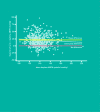Inter-arm blood pressure differences compared with ambulatory monitoring: a manifestation of the 'white-coat' effect?
- PMID: 23561681
- PMCID: PMC3553646
- DOI: 10.3399/bjgp13X663055
Inter-arm blood pressure differences compared with ambulatory monitoring: a manifestation of the 'white-coat' effect?
Erratum in
- Br J Gen Pract. 2013 May;63(610):240
Abstract
Background: Inter-arm difference in blood pressure of >10 mmHg is associated with peripheral vascular disease, but it is unclear how much of the difference in sequential right and left arm blood pressure measurements might be due to a 'white-coat' effect.
Aim: To use ambulatory blood pressure monitoring (ABPM) to better understand the clinical significance of inter-arm differences in blood pressure.
Design and setting: Retrospective study in a teaching hospital in Birmingham.
Method: Anonymised clinical data collected from 784 patients attending a single hospital-based hypertension clinic were retrospectively analysed. Each participant had blood pressure measured sequentially in both arms, followed by ABPM over the subsequent 24 hours.
Result: Data were available for 710 (91%) patients, of whom 39.3% (279) had a blood pressure difference of 10 mmHg or more between each arm. Compared to daytime systolic ABPM, the difference was 25.1 mmHg using the arm with the highest reading, but only 15.5 mmHg if the lower reading was taken (mean difference 9.6 mmHg (95% confidence interval [CI] = 9.0 mmHg to 10.3 mmHg)). However, differences between mean right (20.7 mmHg) or left (19.9 mmHg) arm blood pressure and daytime systolic ABPM were very similar.
Conclusion: Compared with ABPM, use of the higher of the left and right arm readings measured sequentially appears to overestimate true mean blood pressure. As there is no significant difference in the extent of disparity with ABPM by left or right arm, this is unlikely to be due to arm dominance and may be due to the 'white-coat' effect reducing blood pressure on repeated measurement. Where a large inter-arm blood pressure difference is detected with sequential measurement, healthcare professionals should re-measure the blood pressure in the original arm.
Figures


Comment in
-
Inter-arm blood pressure differences compare with ambulatory monitoring: a manifestation of the 'white-coat' effect?Br J Gen Pract. 2013 May;63(610):237. doi: 10.3399/bjgp13X667060. Br J Gen Pract. 2013. PMID: 23643208 Free PMC article. No abstract available.
-
Authors' response.Br J Gen Pract. 2013 May;63(610):237-8. doi: 10.3399/bjgp13x667079. Br J Gen Pract. 2013. PMID: 23781562 Free PMC article. No abstract available.
Similar articles
-
Task force IV: Clinical use of ambulatory blood pressure monitoring. Participants of the 1999 Consensus Conference on Ambulatory Blood Pressure Monitoring.Blood Press Monit. 1999 Dec;4(6):319-31. doi: 10.1097/00126097-199912000-00005. Blood Press Monit. 1999. PMID: 10602536 Review.
-
In the aftermath of SPRINT: further comparison of unattended automated office blood pressure measurement and 24-hour blood pressure monitoring.Blood Press. 2018 Oct;27(5):256-261. doi: 10.1080/08037051.2018.1454258. Epub 2018 Mar 22. Blood Press. 2018. PMID: 29566565
-
[2013 Ambulatory blood pressure monitoring recommendations for the diagnosis of adult hypertension, assessment of cardiovascular and other hypertension-associated risk, and attainment of therapeutic goals (summary). Joint recommendations from the International Society for Chronobiology (ISC), American Association of Medical Chronobiology and Chronotherapeutics (AAMCC), Spanish Society of Applied Chronobiology, Chronotherapy, and Vascular Risk (SECAC), Spanish Society of Atherosclerosis (SEA), and Romanian Society of Internal Medicine (RSIM)].Clin Investig Arterioscler. 2013 Apr-Jun;25(2):74-82. doi: 10.1016/j.arteri.2013.03.002. Epub 2013 Apr 30. Clin Investig Arterioscler. 2013. PMID: 23849214 Spanish.
-
Inter-arm blood pressure differences compare with ambulatory monitoring: a manifestation of the 'white-coat' effect?Br J Gen Pract. 2013 May;63(610):237. doi: 10.3399/bjgp13X667060. Br J Gen Pract. 2013. PMID: 23643208 Free PMC article. No abstract available.
-
Blood Pressure Monitoring. Task force III: Target-organ damage, morbidity and mortality.Blood Press Monit. 1999 Dec;4(6):303-17. doi: 10.1097/00126097-199912000-00004. Blood Press Monit. 1999. PMID: 10602535 Review.
Cited by
-
Usefulness of four-limb blood pressure measurement in prediction of overall and cardiovascular mortality in acute myocardial infarction.Int J Med Sci. 2020 May 23;17(10):1300-1306. doi: 10.7150/ijms.44735. eCollection 2020. Int J Med Sci. 2020. PMID: 32624684 Free PMC article.
-
Inter-arm blood pressure difference and mortality: a cohort study in an asymptomatic primary care population at elevated cardiovascular risk.Br J Gen Pract. 2016 May;66(646):e297-308. doi: 10.3399/bjgp16X684949. Epub 2016 Apr 14. Br J Gen Pract. 2016. PMID: 27080315 Free PMC article. Clinical Trial.
-
Authors' response.Br J Gen Pract. 2013 May;63(610):237-8. doi: 10.3399/bjgp13x667079. Br J Gen Pract. 2013. PMID: 23781562 Free PMC article. No abstract available.
-
A study of the VaSera arterial stiffness device in US patients.J Clin Hypertens (Greenwich). 2017 Jul;19(7):661-668. doi: 10.1111/jch.12967. Epub 2017 Apr 25. J Clin Hypertens (Greenwich). 2017. PMID: 28440017 Free PMC article.
-
Inter-arm difference in blood pressure in patients referred to tertiary hypertension center: Prevalence, risk factors, and relevance to physicians.J Clin Hypertens (Greenwich). 2020 Aug;22(8):1513-1517. doi: 10.1111/jch.13978. Epub 2020 Aug 9. J Clin Hypertens (Greenwich). 2020. PMID: 33448611 Free PMC article.
References
-
- Williams B, Poulter N, Brown M, et al. Guidelines for management of hypertension: report of the fourth working party of the British Hypertension Society. J Hum Hypertens. 2004;18(3):139–185. - PubMed
-
- National Institute for Clinical Excellence. Hypertension: management of hypertension in adults in primary care. Clinical guideline 127. London: NICE; 2011. http://www.nice.org.uk/guidance/CG127/NICEGuidance (accessed 4 Dec 2012)
Publication types
MeSH terms
Grants and funding
LinkOut - more resources
Full Text Sources
Other Literature Sources
Research Materials
